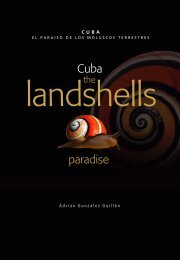Madeira Canary Islands Azores – Fishes Dr. Peter Wirtz
Madeira Canary Islands Azores – Fishes Dr. Peter Wirtz
Madeira Canary Islands Azores – Fishes Dr. Peter Wirtz
Create successful ePaper yourself
Turn your PDF publications into a flip-book with our unique Google optimized e-Paper software.
The first dorsal fin of rocklings is modified into a sensory organ. The fin rays are very short and lie in a<br />
groove. The fin permanently performs a rapid, undulatory movement that draws water through the groove.<br />
Sensory cells then test the odorous substances in the water. During the day, rocklings hide in caves or below<br />
boulders. The Spotted rockling mainly feeds on crustaceans. Reproductive season is in early summer. Photo<br />
<strong>Peter</strong> <strong>Wirtz</strong>.<br />
42<br />
Needle fishes (Belonidae)<br />
Garfish (Belone belone)<br />
Up to 90 cm long. <strong>Madeira</strong>, <strong>Canary</strong> <strong>Islands</strong>. 0 <strong>–</strong> 10 m depth.<br />
Needle fishes usually swim directly below the surface of the water, in small groups or alone. Both jaws are<br />
greatly elongated. Needle fish capture their prey, mainly small fish, with a lightning-fast sidewards movement<br />
of the jaws. Reproductive season in the summer. The eggs are glued to plants by small, sticky threads. Photo<br />
<strong>Peter</strong> <strong>Wirtz</strong>.<br />
Sand smelts (Atherinidae)<br />
Sand smelt (Atherina sp.)<br />
Up to 10 cm long. <strong>Madeira</strong>, <strong>Canary</strong> <strong>Islands</strong>, <strong>Azores</strong>. 1 <strong>–</strong> 30 m depth.<br />
The different Sand smelt species in the area (Atherina hepsetus, Atherina presbyter, possibly also Atherina<br />
boyeri) cannot be told apart on first glance. Sand smelt are frequently confused with sardines. But they do not<br />
have a silvery body, only a silvery line along the body. Also they have two small dorsal fins, not only one.<br />
Sand smelt often form very large schools in shallow water. They are important food for many predatory fish









